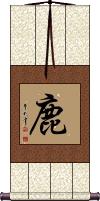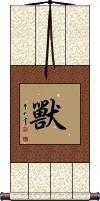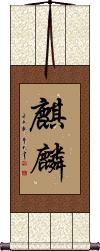Many custom options...
And formats...

Deer in Chinese / Japanese...
Buy a Deer calligraphy wall scroll here!
Personalize your custom “Deer” project by clicking the button next to your favorite “Deer” title below...
Deer
鹿 is the single character for deer in Chinese, Japanese Kanji, and old Korean Hanja.
In Japanese, this can refer especially to the sika deer of Japan (Cervus Nippon).
Beast / Animal
獸 means beast, animal, brute, beastly, or bestial.
Note: A strange selection for a calligraphy wall scroll.
獸 is a very generic term for a beast, so it can be one hunted for food (such as a deer or boar). It can also mean a great animal or someone who acts like a beast.
Note: In Japanese, this can be the personal name Munetada.
![]() In modern Japan, they use the version of this character shown to the right. If your audience in Japanese, click this special Kanji instead of the button above.
In modern Japan, they use the version of this character shown to the right. If your audience in Japanese, click this special Kanji instead of the button above.
Kirin / Giraffe / Mythical Creature
麒麟 is the title of a mythical beast of Asia.
The animal is thought to be related to the giraffe, and in some ways, it is a giraffe. However, it is often depicted with the horns of a dragon or deer and sometimes with the body like a horse, but many variations exist.
In Japanese, it is pronounced “Kirin” as in “Kirin Ichiban” beer.

Notes:
1. This is sometimes spelled as “kylin.”
2. In Japanese, this is the only Kanji word for giraffe. Therefore in Japan, this word needs context to know whether you are talking about the mythical creature or the long-necked giraffe of Africa.
3. Apparently, this was the first word used for regular giraffes in China (some were brought from Africa to China during the Ming Dynasty - probably around the year 1400). Though the mythical creature may have existed before, the name “qilin” was given to the “new giraffe.” This is because, more than 600 years ago, giraffes somewhat matched the mythical creature's description when Chinese people saw them for the first time. Later, to avoid such an ambiguous title, a three-character word was devised to mean a “giraffe of Africa.” The characters for “qilin” shown here are only for the mythological version in modern Chinese.
4. More information about the qilin / kirin from Wikipedia.
5. This creature is sometimes translated as the “Chinese Unicorn,” although it is generally portrayed with two horns. I think this is done more for the fantasy aspect of the unicorn and because most westerners don't know what a qilin or kirin is (this avoids a long explanation by the translator).
6. In Korean, this can mean kirin or simply giraffe (usually, the mythological creature is what they would think of when seeing these characters alone on a wall scroll).
Not the results for deer that you were looking for?
Below are some entries from our dictionary that may match your deer search...
| Characters If shown, 2nd row is Simp. Chinese |
Pronunciation Romanization |
Simple Dictionary Definition |
月 see styles |
yuè yue4 yüeh runa るな |
More info & calligraphy: Moon(1) Moon; (2) month; (3) moonlight; (4) (See 衛星・1) (a) moon; natural satellite; (female given name) Runa candra, 旅達 (旅達羅); 旂陀羅; 戰達羅; 戰捺羅 the moon, called also 蘇摩 soma, from the fermented juice of asclepias acida used in worship, and later personified in association with the moon. It has many other epithets, e. g. 印度 Indu, incorrectly intp. as marked like a hare; 創夜神 Niśākara, maker of the night; 星宿王 Nakṣatranātha, lord of constellations; 喜懷之頭飾 the crest of Siva; 蓮華王 Kumuda-pati, lotus lord; 白馬主 Śvetavājin, drawn by (or lord of) white horses; 大白光神 Śītāṃśu, the spirit with white rays; 冷光神 Sitamarici, the spirit with cool rays; 鹿形神 Mṛgāṅka, the spirit with marks m form like a deer; 野兎形神 Śaśi, ditto like a hare. |
鹿 see styles |
lù lu4 lu roku ろく |
More info & calligraphy: Deerdeer (esp. the sika deer, Cervus nippon); cervid; (personal name) Roku mṛga; a deer; as Śākyamuni first preached the four noble truths in the Deer-garden, the deer is a symbol of his preaching. |
ティア see styles |
dia ディア |
(See 鹿) deer; (personal name) Dia |
狍 see styles |
páo pao2 p`ao pao |
Siberian roe deer (Capreolus pygargus) |
獐 see styles |
zhāng zhang1 chang |
river deer; roebuck |
羯 see styles |
jié jie2 chieh ketsu けつ |
ram, esp. gelded; to castrate; deer's skin Jie (ancient Chinese ethnic group) To castrate; deer-skin; translit. ka, gha. Cf. 迦, 拘, 軻, 朅, 竭, etc. |
鏑 镝 see styles |
dí di2 ti kabura かぶら |
arrow or arrowhead (old) (1) (abbreviation) (See 蕪) turnip-shaped whistle made of hollowed-out wood or deer horn (attached to an arrow to sound when fired); (2) (See 鏑矢) arrow with such a whistle attached; (surname) Kabura |
麀 see styles |
yōu you1 yu |
female deer; doe; female animal |
麃 see styles |
páo pao2 p`ao pao |
(archaic) a type of deer |
麈 see styles |
zhǔ zhu3 chu shu |
leader of herd; stag A great deer, whose tail is used as a fly-whip; the use of which is forbidden to monks. |
麋 see styles |
mí mi2 mi oojika おおじか |
moose; river bank (1) large deer; (2) moose; elk; red deer |
麕 see styles |
jun jun1 chün noro のろ |
variant of 麇[jun1] (kana only) European roe deer (Capreolus capreolus) |
麖 see styles |
jīng jing1 ching |
red deer |
麝 see styles |
shè she4 she |
musk deer (Moschus moschiferus); also called 香獐子 |
麠 see styles |
jīng jing1 ching |
red deer; sambar deer |
三乘 see styles |
sān shèng san1 sheng4 san sheng minori みのり |
(surname) Minori Triyāna, the three vehicles, or conveyances which carry living beings across saṁsāra or mortality (births-and-deaths) to the shores of nirvāṇa. The three are styled 小,中, and 大. Sometimes the three vehicles are defined as 聲聞 Śrāvaka, that of the hearer or obedient disciple; 緣覺Pratyeka-buddha, that of the enlightened for self; these are described as 小乘 because the objective of both is personal salvation; the third is 菩薩Bodhisattva, or 大乘 Mahāyāna, because the objective is the salvation of all the living. The three are also depicted as 三車 three wains, drawn by a goat, a deer, an ox. The Lotus declares that the three are really the One Buddha-vehicle, which has been revealed in three expedient forms suited to his disciples' capacity, the Lotus Sūtra being the unifying, complete, and final exposition. The Three Vehicles are differently explained by different exponents, e.g. (1) Mahāyāna recognizes (a) Śrāvaka, called Hīnayāna, leading in longer or shorter periods to arhatship; (b) Pratyeka-buddha, called Madhyamayāna, leading after still longer or shorter periods to a Buddhahood ascetically attained and for self; (c) Bodhisattva, called Mahayana, leading after countless ages of self-sacrifce in saving others and progressive enlightenment to ultimate Buddhahood. (2) Hīnayāna is also described as possessing three vehicles 聲, 緣, 菩 or 小, 中, 大, the 小 and 中 conveying to personal salvation their devotees in ascetic dust and ashes and mental annihilation, the 大 leading to bodhi, or perfect enlightenment, and the Buddha's way. Further definitions of the Triyāna are: (3) True bodhisattva teaching for the 大; pratyeka-buddha without ignorant asceticism for the 中; and śrāvaka with ignorant asceticism for the 小. (4) (a) 一乘 The One-Vehicle which carries all to Buddhahood: of this the 華嚴 Hua-yen and 法華 Fa-hua are typical exponents; (b) 三乘法 the three-vehicle, containing practitioners of all three systems, as expounded in books of the 深密般若; (c) 小乘 the Hīnayāna pure and simple as seen in the 四阿合經 Four Āgamas. Śrāvakas are also described as hearers of the Four Truths and limited to that degree of development; they hear from the pratyeka-buddhas, who are enlightened in the Twelve Nidānas 因緣; the bodhisattvas make the 六度 or six forms of transmigration their field of sacrificial saving work, and of enlightenment. The Lotus Sūtra really treats the 三乘. Three Vehicles as 方便 or expedient ways, and offers a 佛乘 Buddha Vehicle as the inclusive and final vehicle. |
三漸 三渐 see styles |
sān jiàn san1 jian4 san chien sanzen |
The three progressive developments of the Buddha's teaching according to the Prajñā school: (a) the 鹿苑 initial stage in the Lumbinī deer park; (b) the 方等 period of the eight succeeding years; (c) the 般若 Prajñā or wisdom period which succeeded. |
三車 三车 see styles |
sān chē san1 che1 san ch`e san che sansha |
triyāna. 三乘 or 三乘法門 (1) The three vehicles across saṃsāra into nirvāṇa, i.e. the carts offered by the father in the Lotus Sutra to lure his children out of the burning house: (a) goat carts, representing śrāvakas; (b) deer carts, pratyekabuddhas; (c) bullock carts, bodhisattvas. (2) The three principal schools of Buddhism— Hīnayāna, Madhyamayāna, Mahāyāna. |
三轉 三转 see styles |
sān zhuǎn san1 zhuan3 san chuan santen |
(三轉法輪) The three turns of the law-wheel when the Buddha preached in the Deer Park: (a) 示轉 indicative, i.e. postulation and definition of the 四諦; (b) 勸轉 hortative, e.g. 苦當知 suffering should be diagnosed; (c) 證轉 evidential, e.g. I have overcome suffering, etc. |
五時 五时 see styles |
wǔ shí wu3 shi2 wu shih goji |
(五時教) The five periods or divisions of Śākyamuni's teaching. According to Tiantai they are (1) 華嚴時 the Avataṃsaka or first period in three divisions each of seven days, after his enlightenment, when he preached the content, of this sutra; (2) 鹿苑時 the twelve years of his preaching the Āgamas 阿含 in the Deer Park; (3) 方等時 the eight years of preaching Mahāyāna-cum-Hīnayāna doctrines, the vaipulya period; (4) 般若時 the twenty-two years of his preaching the prajñā or wisdom sutras; (5) 法華涅槃時 the eight years of his preaching the Lotus Sutra and, in a day and a night, the Nirvana Sutra. According to the Nirvana School (now part of the Tiantai) they are (1) 三乘別教 the period when the differentiated teaching began and the distinction of the three vehicles, as represented by the 四諦 Four Noble Truths for śrāvakas, the 十二因緣 Twelve Nidānas for pratyekabuddhas, and the 六度 Six Pāramitās for bodhisattvas; (2) 三乘通教 the teaching common to all three vehicles, as seen in the 般若經; (3) 抑揚教 the teaching of the 維摩經, the 思益梵天所問經, and other sutras olling the bodhisattva teaching at the expense of that for śrāvakas; (4) 同歸教 the common objective teaching calling all three vehicles, through the Lotus, to union in the one vehicle; (5) 常住教 the teaehmg of eternal life i. e. the revelation through the Nirvana sutra of the eternity of Buddhahood; these five are also called 有相; 無相; 抑揚; 曾三歸—; and 圓常. According to 劉虬 Liu Chiu of the 晉 Chin dynasty, the teaching is divided into 頓 immediate and 漸 gradual attainment, the latter having five divisions called 五時教 similar to those of the Tiantai group. According to 法寶 Fabao of the Tang dynasty the five are (1) 小乘; (2) 般着 or 大乘; (3) 深密 or 三乘; (4) 法華 or 一乘; (5) 涅槃 or 佛性教. |
光宅 see styles |
guāng zhái guang1 zhai2 kuang chai Kōtaku |
Kuang-chai, name of the temple where 法雲 Fa-yun early in the sixth century wrote his commentary on the Lotus Sutra, which is known as the 光宅疏; 光宅 became his epithet. He made a division of four yāna from the Burning House parable, the goat cart representing the śrāvaka, the deer cart the pratyekabuddha, the ox-cart the Hīnayāna bodhisattva, and the great white ox-cart the Mahāyāna bodhisattva; a division adopted by T'ien-t'ai. |
參茸 参茸 see styles |
shēn róng shen1 rong2 shen jung |
ginseng and young deer antler (used in TCM) |
吠鹿 see styles |
hoejika; hoejika ほえじか; ホエジカ |
(kana only) common muntjac (species of barking deer, Muntiacus muntjak); Indian muntjac |
呦呦 see styles |
yōu yōu you1 you1 yu yu |
(literary) (onom.) bleating of a deer |
四乘 see styles |
sì shèng si4 sheng4 ssu sheng shijō |
The goat, deer, and ox carts and the great white-bullock cart of the Lotus Sutra, see 四車. |
四車 四车 see styles |
sì chē si4 che1 ssu ch`e ssu che yotsuguruma よつぐるま |
(surname) Yotsuguruma The four vehicles 四乘 of the Lotus Sutra 譬喩品, i. e. goat, deer, bullock, and great white-bullock carts. |
坡鹿 see styles |
pō lù po1 lu4 p`o lu po lu |
Eld's deer (Panolia eldii) |
大乘 see styles |
dà shèng da4 sheng4 ta sheng oonori おおのり |
Mahayana, the Great Vehicle; Buddhism based on the Mayahana sutras, as spread to Central Asia, China and beyond; also pr. [Da4 cheng2] (surname) Oonori Mahāyāna; also called 上乘; 妙乘; 勝乘; 無上乘; 無上上乘; 不惡乘; 無等乘, 無等等乘; 摩訶衍 The great yāna, wain, or conveyance, or the greater vehicle in comparison with the 小乘 Hīnayāna. It indicates universalism, or Salvation for all, for all are Buddha and will attain bodhi. It is the form of Buddhism prevalent in Tibet, Mongolia, China, Korea, Japan, and in other places in the Far East. It is also called Northern Buddhism. It is interpreted as 大教 the greater teaching as compared with 小教 the smaller, or inferior. Hīnayāna, which is undoubtedly nearer to the original teaching of the Buddha, is unfairly described as an endeavour to seek nirvana through an ash-covered body, an extinguished intellect, and solitariness; its followers are sravakas and pratyekabuddhas (i.e. those who are striving for their own deliverance through ascetic works). Mahāyāna, on the other hand, is described as seeking to find and extend all knowledge, and, in certain schools, to lead all to Buddhahood. It has a conception of an Eternal Buddha, or Buddhahood as Eternal (Adi-Buddha), but its especial doctrines are, inter alia, (a) the bodhisattvas 菩薩 , i.e. beings who deny themselves final Nirvana until, according to their vows, they have first saved all the living; (b) salvation by faith in, or invocation of the Buddhas or bodhisattvas; (c) Paradise as a nirvana of bliss in the company of Buddhas, bodhisattvas, saints, and believers. Hīnayāna is sometimes described as 自利 self-benefiting, and Mahāyāna as 自利利他 self-benefit for the benefit of others, unlimited altruism and pity being the theory of Mahāyāna. There is a further division into one-yana and three-yanas: the trīyāna may be śrāvaka, pratyeka-buddha, and bodhisattva, represented by a goat, deer, or bullock cart; the one-yāna is that represented by the Lotus School as the one doctrine of the Buddha, which had been variously taught by him according to the capacity of his hearers, v. 方便. Though Mahāyāna tendencies are seen in later forms of the older Buddhism, the foundation of Mahāyāna has been attributed to Nāgārjuna 龍樹. "The characteristics of this system are an excess of transcendental speculation tending to abstract nihilism, and the substitution of fanciful degrees of meditation and contemplation (v. Samādhi and Dhyāna) in place of the practical asceticism of the Hīnayāna school."[Eitel 68-9.] Two of its foundation books are the 起信論and the 妙法蓮華經 but a larnge numberof Mahāyāna sutras are ascribed to the Buddha。. |
大鹿 see styles |
dà lù da4 lu4 ta lu oshika おしか |
moose (1) large deer; (2) moose; elk; red deer; (surname) Oshika |
天祿 天禄 see styles |
tiān lù tian1 lu4 t`ien lu tien lu |
auspicious sculpted animal, usu. a unicorn or deer with a long tail; possession of the empire See: 天禄 |
Click here for more deer results from our dictionary
The following table may be helpful for those studying Chinese or Japanese...
| Title | Characters | Romaji (Romanized Japanese) | Various forms of Romanized Chinese | |
| Deer | 鹿 | shika / ka | lù / lu4 / lu | |
| Beast Animal | 獸 兽 | shishi | shòu / shou4 / shou | |
| Kirin Giraffe Mythical Creature | 麒麟 | kirin | qí lǐn / qi2 lin3 / qi lin / qilin | ch`i lin / chilin / chi lin |
| In some entries above you will see that characters have different versions above and below a line. In these cases, the characters above the line are Traditional Chinese, while the ones below are Simplified Chinese. | ||||
Successful Chinese Character and Japanese Kanji calligraphy searches within the last few hours...






